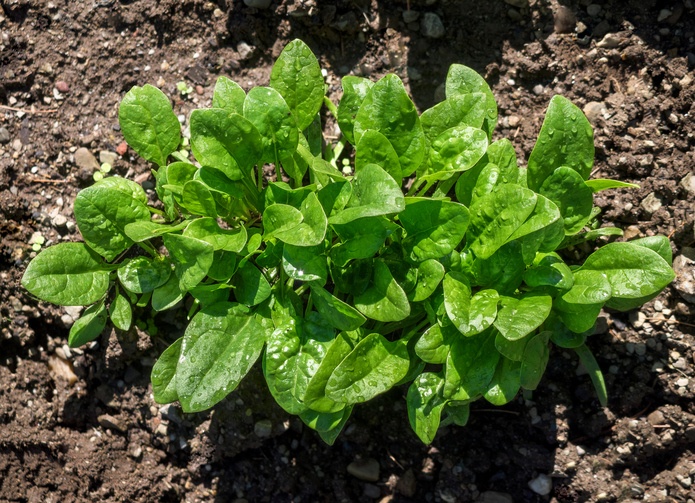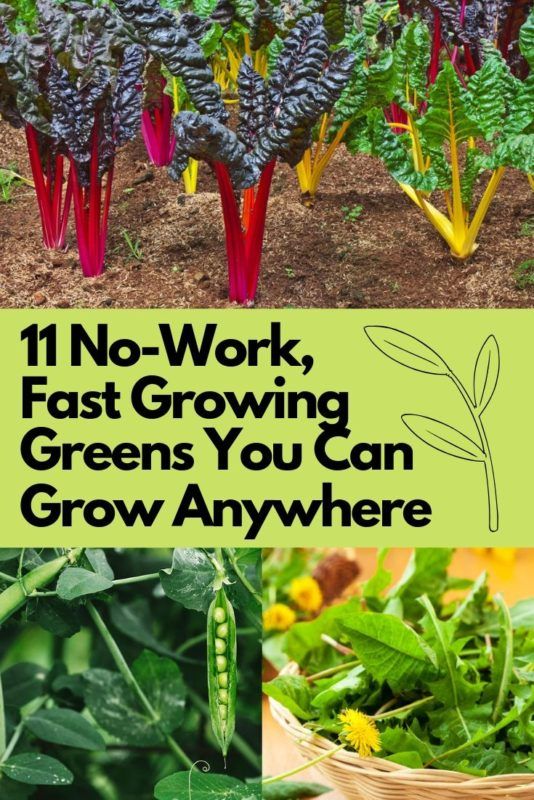
Greens are jam-packed with vitamins, minerals, and disease-fighting phytochemicals. They’re rich in fiber, which is important for supporting weight loss and maintenance as it keeps you feeling full and helps control your hunger. There is little that compares to the nutritional value of organic greens, but as only about one-quarter of American adults eat three or more servings of vegetables a day, most are severely lacking in the nutrients they offer.
Of course, most of us realize that eating more produce is a good idea, and we also understand that going organic to avoid chemicals is important too – but at the same time, the cost of paying for those organic greens, can be hard to stomach. Growing your own greens not only helps to ensure that you eat them more often, it’s a whole lot more affordable. You might be surprised at just how easy and fast it is to grow them, especially when you choose these trouble-free options for planting.
1. Green beans
Green beans one of the tastiest, most versatile vegetables out there. They’re also highly nutritious, loaded with carotenoids, primarily beta-carotene and lycopene. Both of these substances offer antioxidant properties, which means they’re outstanding when it comes to fighting disease.
There are also many different types of green beans that are ideal for growing in a home garden – in fact, there are hundreds of varieties to choose from. Bush beans are particularly easy and require little space, plus they mature earlier than pole varieties. As its a bush variety, there’s no need for staking, and they’re easy to pick too. You might want to try the burgundy or purple variety, which is especially pretty to look at with its vibrant outside, while the insides are green – once cooked, the exterior will be green too.
Most green beans prefer well-drained soil and full sun. Bush beans will produce most of its harvest within a few weeks, which means there will even be time for a second crop.
2. Beet greens
Most people eat the root of this plant, known as beetroot, and throw away the greens. That’s a shame because beet greens are super nutritious, with large amounts of copper, iron and vitamin K as well as a number of other vitamins and minerals. Plus the greens can be used many different ways, from salads to sauteeing them in olive oil or even tossed into a healthy smoothie.
Beets are a fast-growing vegetable that can be grown just about anywhere and require hardly any work at all. You can plant them as soon as your soil can be worked in the spring. Harvesting the greens comes when they are a couple of inches tall – they’re tender before they reach six inches. Beetroots will be ready to harvest when they are about one-and-a-half to two inches in diameter – if they get too big, they’ll be really tough.
3. Spinach
Popeye is famous for loving his spinach, and the rest of us all should too. Eating it regularly has been linked to lowering the risk of asthma, cancer, and hypertension while promoting healthier hair and skin, as well as for managing diabetes.
If you plant spinach in your garden, it will be ready in as little as 3 to 5 weeks after planting. Early spring is a great time for planting, and when it’s time to harvest, all you have to do is cut the leaves off with scissors as you need them – no worries, they’ll grow back.
4. Kale
Another fantastic leafy green, kale is a true superfood, providing just 30 calories in a cup, but offering seven times the daily recommended amount of vitamin K, a day’s worth of vitamin C, double the amount of vitamin A, and a host of minerals, antioxidants and more. It also boasts anti-inflammatory properties that may help prevent arthritis, heart disease, diabetes and autoimmune diseases, along with omega-3 fatty acids to help build cell membranes and more.
Kale grows all season long, but its flavor is sweeter after a frost. It’s incredibly hearty, surviving temperatures as low as 10 degrees Fahrenheit, so most people can grow even well into fall and even through winter. It will be ready just a month after planting.
5. Snap peas
Snap peas are a fast-growing cool-season plant that offers a sweet treat right from the vine – and, of course, they’re just as wonderful when cooked up into a side dish. Not only are snap peas easy to grow, but they are also quite prolific, producing an abundance of little green pods every year. They’re also a “vertical” grower, making them ideal when space is tight.
Snap peas provide a third of the daily recommended value for vitamin C and 3 grams of fiber in every cup. Plus, these greens are hearty – they germinate in soil temperatures as low as 40 degrees Fahrenheit. The downside is that they don’t like dry, hot weather, but if you plant them so they can mature as early as your planting schedule allows, you can sow more seeds when the cooler days of fall arrive.
6. Rainbow chard
Chard belongs to the same family as beets and spinach, the chenopod family. Not only is it a rich source of vitamins A, C, and E, zinc, and manganese, it’s quite hearty and grows easily, while making an attractive addition to your garden with its bright red stems. As rainbow chard degrades quickly during shipping, it’s far better to grow it at home. By planting in early spring, you can even harvest it all season long.
7. Mustard greens
Spicy, peppery mustard greens are fabulous for adding a zing to a salad, and they’re fast growing too. They do best with lots of sun and rich, moist soil. You can begin picking leaves in about 4 weeks when the leaves are 6 to 8 inches long. If you want larger leaves, left alone, they’ll reach their full size of 15 to 18 inches long in about 6 weeks.
Mustard greens are especially rich in vitamins A, C, and K, and are also an excellent source of folate as well as containing a ton of antioxidants that are known to help lower cholesterol and detoxify the liver.
8. Bok choy
Bok choy is another highly nutritious green leafy vegetable that’s also referred to as the Chinese cabbage or pakchoi. It adds a tasty flavor and texture to a stir-fry and is also good in soups and salads. Especially popular in Southeast Asia, it contains more vitamin A than any other variety of cabbage, along with a high level of beta-carotene, vitamins C and K. It also offers important nutrients like potassium, magnesium, calcium and manganese.
Although bok choy is planted early in the season, you can start a second crop in late summer to be ready late fall. They only take 45-50 days to maturity, so this is easily done. The leaves can be harvested when they’re about three inches tall, or you can wait until the head forms and harvest the whole plant at once.
9. Scallions
Scallions, also known as green onions and spring onions, contain a wide variety of health-enhancing compounds, including more fiber, vitamin C, and potassium than regular onions. They’re best-known for their ability to help protect one from lung and oral cancer, lower blood pressure and reduce cholesterol levels. Use them raw in salads, or cook them with other vegetables in a saute or stir-fry.
10. Lettuce
It’s hard to beat a fresh salad from your own yard, and when it comes to lettuce, you have a massive category of plants to choose from, including romaine, microgreens, arugula, leaf lettuces and head lettuces – all of which are easy to grow and maintain. Not only are these leafy greens a cinch, the loose-leaf varieties mature in just 3 to 4 weeks. They prefer the cooler temperatures of spring or fall – successive sowings every two weeks will help space out your harvest.
11. Dandelion greens
Dandelions are so easy to grow, most gardeners consider them a weed, and look for information on how to get rid of them. Once you realize just how nutritious they are, you’ll understand how big that mistake really is. They’re filled with antioxidants, are high in vitamin A in the form of the antioxidant carotenoid, also known as beta-carotene, as well as vitamin C. They’re an especially good source of calcium and iron, along with a host of other minerals like copper, manganese, phosphorus, potassium and magnesium. Dandelions contain more protein per serving them spinach, with the greens themselves providing all essential amino acids. And, you can eat the roots too – they contain inulin and luteolin, which are known to help regulate blood sugar as well as taraxacin.
You really don’t need to do much at all to grow dandelions – in fact, you may even have a yard full of them. Those dandelion plants are probably common dandelions, which contain the benefits mentioned, but they do tend to be a little more bitter than some of the other varieties. That’s why you may want to consider planting a gourmet variety such as French dandelion, Arlington dandelion or Ameliore dandelion. The greens can be harvested throughout the growing season.
Pin This To Save For Later

